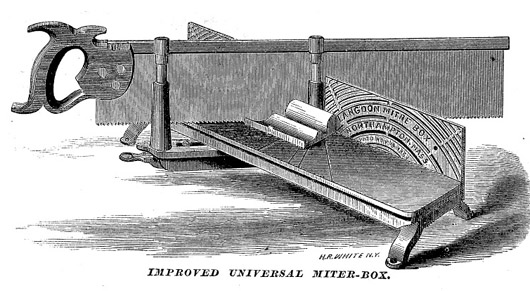No carpenter of the present day who understands his trade can do
without a correct miter-box. It is the general custom of
carpenters to make their miter-boxes entirely out of wood, and use
the same until worn out. If work thus fitted often becomes
inaccurate by the wearing out of the miter-box, the workman makes
another box.
We need not say that in order to make well-fitting work in all cases
of out-of-the-way and odd jobs, such a miter-box is insufficient,
and that even in ordinary work it is not entirely reliable.
For this reason this old style of tool is now being superseded by an
improved and adjustable implement, which, notwithstanding it costs
more at first, will undoubtedly prove cheaper in the end, as it
never necessitates any loss of time by fitting or trimming to make
perfect joints.

It is called the Langdon Adjustable
Miter-Box, manufactured by the Northampton Pegging Machine
Company, of Northampton, Mass. It is made of iron, and with
fair usage will last for years. It stands upon legs of some
two inches high, and is so constructed that by moving the swinging
lever which passes under the machine, the required angle can be
obtained with unerring accuracy. The stops for each angle are
positive exact and self-fastening. A hollow post or tube is
attached to each end of the swinging lever for the support of the
saw guides.
Each miter-box is provided with a first quality back-saw, (Henry
Disston & Sons or otherwise,) 18, 20, 22, or 24 inches in
length, manufactured expressly for the same. The saw runs
through iron guides, fitting as closely as is consistent with its
easy motion, an enlarged opening being provided for the free passage
of the teeth of the saw.
These saw-guides are nicely adjusted
and fitted into the hollow posts or tubes at either end of the
swinging lever, and move together with the saw up and down and with
the swinging lever to the desired angle. The saw guides rest
upon screws, by which they can be raised or lowered, according to
the varying width of the saw or the style of work required to be
done. With a good saw, properly filed and set, good joints,
requiring no trimming or fitting, are certain.
These boxes are made so as to admit a board or molding 6 inches wide
at right angles and 4 inches wide at miter, or with an extension
lever, will admit a board 9 inches wide at right angles and 6 inches
wide at miter. When desired, the box is also provided with an
adjustable attachment for making tenons, scarfing, making rustic
frames, etc., and when adjusted retains its position, sawing tenons
or otherwise, exactly alike until re-adjusted.
Taken as a whole, it is one of the most desirable and long-needed
improvements in the outfit of wood-workers which has come to our
notice, and we are glad to know that the manufacturers, who have
expended no little time and money in perfecting this invention, are
finding a ready appreciation of the same by the community.
The Manufacturer and Builder, Vol. 5, May 1873,
(New York: Engineers' & Manufacturers' Publishing Co.)
Related Info:
Wiktor A. Kuc
March, 2013
We want to hear from you - write to:
info@wkFineTools.com